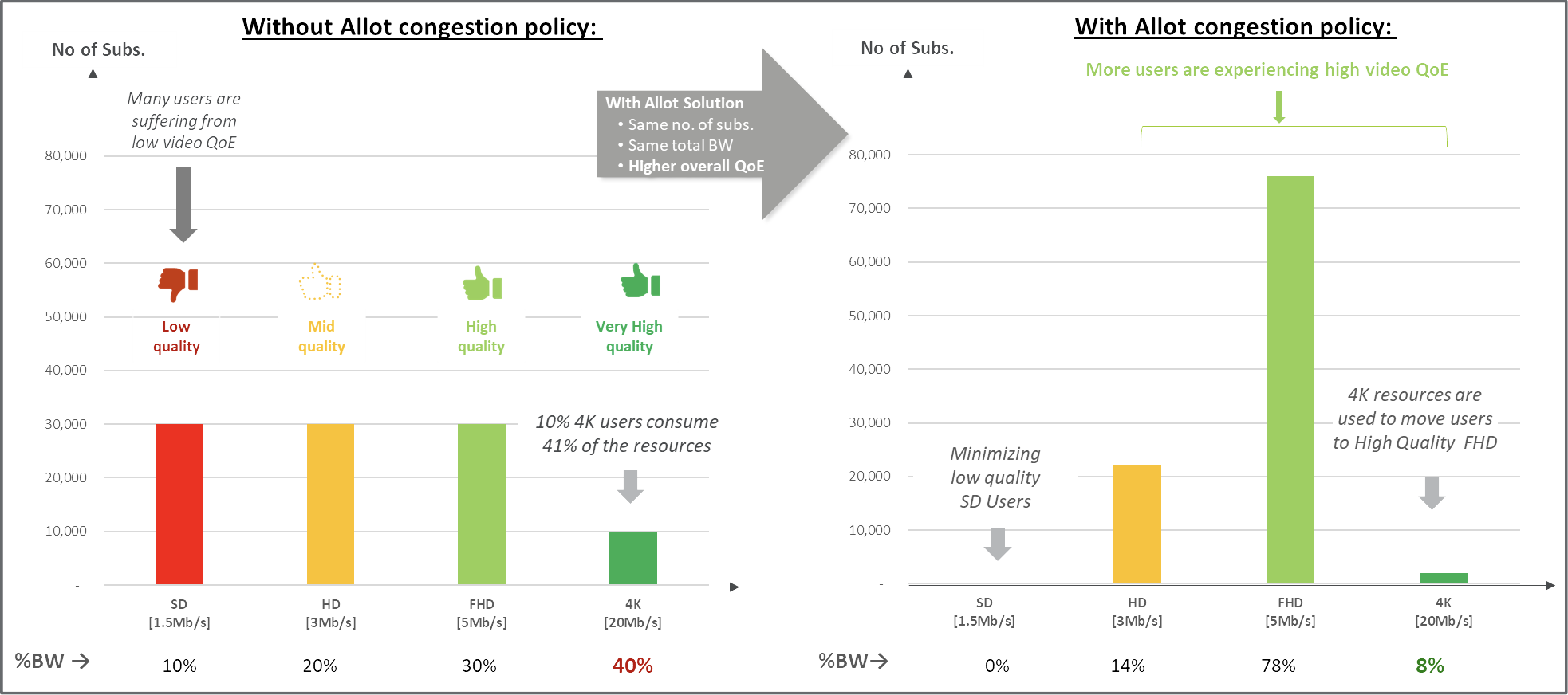
Smooth Streaming: How to Beat FWA Network Congestion
Unveiling the Cause: Why Your FWA Network Stutters
Video reigns supreme in today’s digital age, but its dominance comes at a cost for all networks, and Fixed Wireless Access (FWA) networks are no exception. As demand for high-quality streaming surges, network congestion during peak time has become the normal and greatly impacts QoE. This blog explores the impact of video traffic on FWA networks and how innovative solutions can rebalance bandwidth for a smoother streaming future.
The Neverending Stream: Why We Crave Flawless Video
FWA networks grapple with three primary challenges: high equipment costs, complex deployment processes, and relentless congestion. However, the biggest hurdle stems from a seemingly insatiable appetite for high-quality video streaming. Today’s viewers are no longer satisfied with blurry, pixelated experiences, they crave flawless video because it unlocks a deeper level of enjoyment. High-definition visuals and crisp audio create a more immersive experience, whether it’s feeling like you’re in the front row at a concert or appreciating the intricate details in a nature documentary. There’s also an element of meeting expectations. Content creators invest heavily in producing high-quality videos, and viewers deserve to see that quality reflected in their streaming experience. Ultimately, flawless video translates to seamless viewing. No buffering interruptions or frustrating pixelation – just uninterrupted enjoyment from the first frame to the last. This desire for a smooth, high-quality experience is what puts immense pressure on FWA network resources and contributes significantly to congestion.
Just How Much of Our Bandwidth Does Video Consume?
Video is a significant bandwidth consumer, already accounting for over a staggering 80% of all network traffic. Several factors contribute to this dominance, including the number of viewers streaming video and the quality of the content they choose. As video resolution increases, so do the bandwidth requirements.
From Pixelated to Crystal Clear
Video resolution standards play a crucial role in determining video quality, as they define the number of pixels used to display an image on the screen. Higher resolutions, such as 4K, provide sharper and more detailed visuals compared to lower resolutions like full HD. On a 4k TV, you can view the content in much more detail than on 1080p TVs. By all means, 4K delivers enhanced quality and higher resolution images as compared to Full HD. However, if network congestion is a concern, one might opt for FHD as it offers a perfectly fine experience in terms of viewing. Here’s a breakdown of expected video quality per different video resolution standards:
Video Resolution Standard Sets Video Quality
|
Video Res. Standard |
Video Quality |
Bandwidth |
|
SD (Standard Definition) |
Poor |
1.5Mb |
|
HD (High Definition) |
Adequate |
3Mb |
|
FHD (Full HD) |
Very Good |
5Mb |
|
4K (Ultra HD) |
Excellent |
20Mb |
Bandwidth Hogs vs. Fair Share: The Traffic Jam on Your FWA Network
Imagine a highway where a few luxury cars occupy all available lanes, leaving the rest of the traffic at a standstill. Similarly, it only takes a handful of users streaming in 4K to drastically reduce the available bandwidth for others, resulting in poor QoE for the majority. This imbalance presents a significant challenge for FWA providers who need to deliver satisfactory QoE even during peak usage times, ensuring that all users have a satisfactory experience, not just the fortunate few.
Visualizing the Impact: Bandwidth Distribution With and Without Allot
In the battle against network congestion, managing video bandwidth is critical. Without intelligent traffic management, events like live sports broadcasts could create an unfair bandwidth distribution with a few 4K streamers monopolizing bandwidth and leaving the majority with a subpar experience – buffering issues and poor video quality. The following graphs present disparity vs harmony in the QoE of video streaming in an FWA network – with and without Allot’s congestion policy deployed inline:

Video Streaming on FWA Network – With and W/O Allot
On the left: The graph analyzes a hypothetical network with 100,000 subscribers and shows the video bandwidth distribution during peak hour, where a small proportion of subscribers (10%, 10,000) stream 4K video and consume a disproportionate amount of available network bandwidth (40%). These bandwidth hoggers are spoiling the QoE for a considerable number of other subscribers; 30% of subscribers (30,000) experience poor video quality, and another equal number of subscribers are only able to experience mediocre quality.
On the right: The graph illustrates the harmonious and balanced bandwidth allocation achieved through Allot’s video-aware policies included in its traffic management solution. These results demonstrate how the network adapts in real-time, reallocating bandwidth to ensure even distribution. The percentage of customers enjoying high-quality FHD video has increased from 10% to 75%, while the low-quality SD streams have been drastically reduced from 9% of subscribers to 0%. To free resources for this improvement, the number of subscribers watching 4K video was reduced, but they are still receiving FHD.
Smart Traffic Controller for the Digital Highway
Advanced traffic management solutions act like intelligent traffic controllers on the digital highway, offering a sophisticated and adaptable approach that ensures fair and efficient bandwidth distribution, consistently high Quality of Experience (QoE) across all users, and enhanced overall network performance. By leveraging these solutions, Fixed Wireless Access (FWA) providers can meet current demands without the need for immediate network expansion, while also futureproofing their networks against the ever-growing appetite for high-quality video content.
Allot’s Advanced Solution Flexibility
Allot’s Traffic Management solution is designed to apply the video bandwidth management features specifically during periods of network congestion. Additionally, it takes into account subscriber service plans, ensuring that high-end subscribers who pay more enjoy a superior QoE.
FAQ
The primary challenge facing FWA networks is network congestion caused by the increasing demand for high-quality video streaming. This congestion leads to inferior quality of experience (QoE) for users, with issues like buffering and pixelation.
Video consumption is a major contributor to network congestion on FWA networks. It accounts for a sizable portion of overall network traffic, with high-definition and ultra-high-definition videos requiring substantial bandwidth. This imbalance in bandwidth usage leads to a poor experience for most users, as a small number of high-bandwidth consumers can significantly impact overall network performance.
Network congestion on FWA networks results in an inadequate quality of experience (QoE) for users. This manifests in issues such as buffering, pixelation, and overall video quality degradation. As a result, user satisfaction decreases, and churn rates may increase.
FWA providers can address network congestion by implementing advanced traffic management solutions. These solutions help to balance bandwidth distribution, ensuring a fair share for all users. By prioritizing traffic and optimizing network resources, providers can improve overall network performance and deliver a better
user experience.


